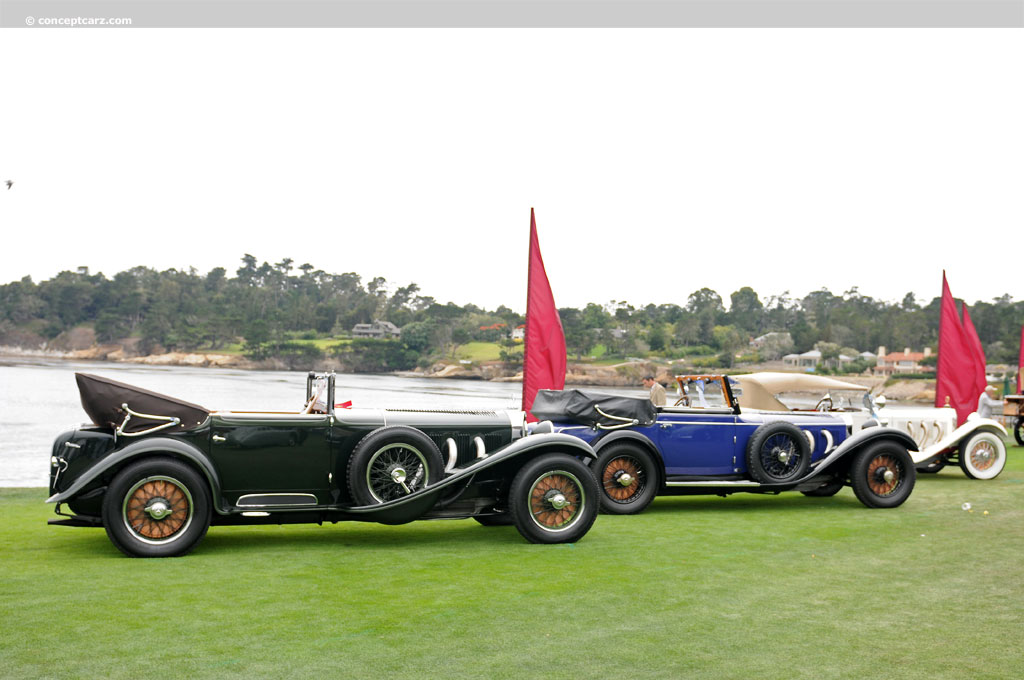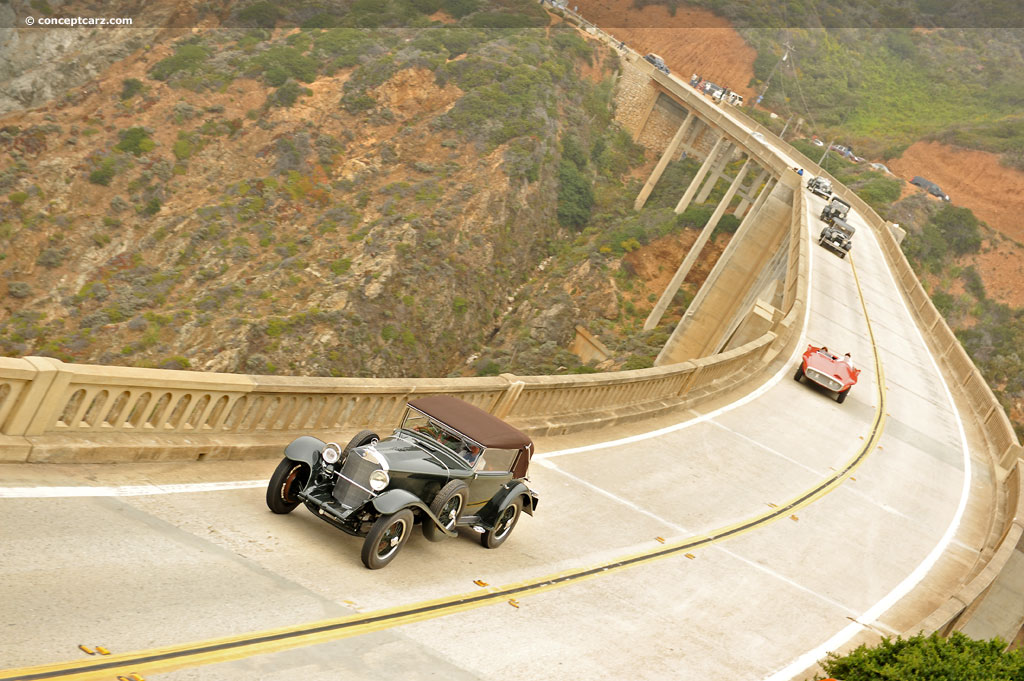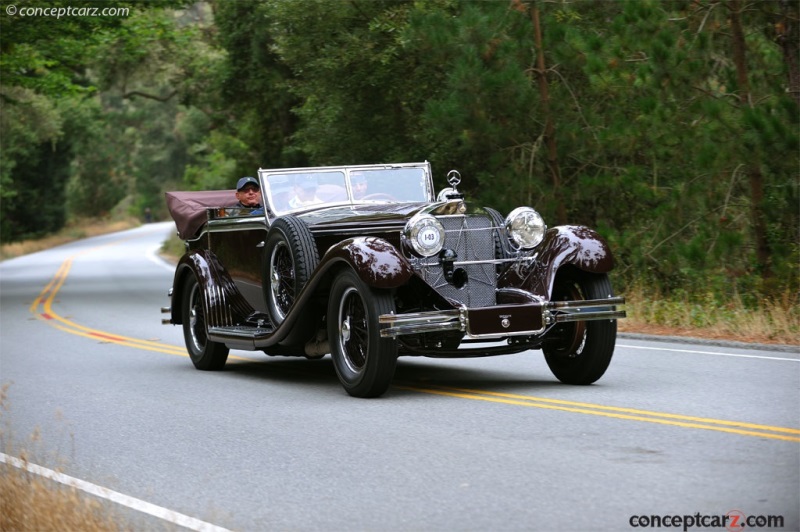Benz & Cie. and DMG merged as the Daimler-Benz company on June 28th of 1926, with all of its automobiles becoming Mercedes-Benz. The first models produced following the union were the Model 630 K. The 'K' represented 'Kurtz' meaning short, and were officially designated 24/100/140. The 24 referred to the taxable horsepower (function of engine displacement) and the 100 was the actual horsepower. The third number, 140, was the horsepower with the supercharger engaged. During the early 1920s, Mercedes had led the way in using superchargers in road-going vehicles, incorporating lessons learned from building aircraft engines for high altitude operation during the Great War. All Mercedes-Benz cars built prior to World War II and equipped with superchargers employed an 'on demand' system that only came into operation when the throttle pedal was fully depressed, which clutched in the Roots-type blower to boost acceleration and raise power output. In regards to the 6.8-liter 'S' Series of 1927, power output rose from 140 bhp to 200 brake horsepower with the supercharger engaged. 
Tourenwagen
View info and historyThe 6.8-liter 'S' Series was the work of the company's new chief designer Ferdinand Porsche. It retained the dimensions of the Model K chassis, but the frame was lowered and the engine was moved rearward by 30 cm. The 'SS' or 'Super Sport' grand tourer followed in mid-1928, equipped with a 7.1-liter version of the M06 engine. The SS was very exclusive with just 102 units constructed. The Mercedes-Benz S and SS models were among the most luxurious and powerful automobiles of the late 1920s, and many were clothed by the most skilled craftsman of the day. Many of the cars were constructed of aluminum to minimize weight. The Mercedes-Benz SS (for 'Super Sport') was powered by a 7.1-liter, inline six-cylinder engine developed up to 160 horsepower in naturally aspirated form and up to 200 horsepower with a supercharger engaged. 
Tourenwagen
View info and historyIn late 1928, Mercedes-Benz introduced the SSK, which stood for 'Super Sport Kurz' (German for 'Super Sport Short'). Designed for hill climb competition, the SSK had a shortened wheelbase of 2950mm and was fitted with a tuned version of the SS engine but with the lower radiator of the Model S. Factory driver Rudi Caracciola drove the SSK to 26 hill climb victories over a two year period. Just like the S and SS, the SSK was both a production and race car. Over a three-year period, a total of 31 examples were built. The ultimate evolution of the SSK was the SSKL ('L' representing Leicht or light), which arrived in 1931. Its reduced weight was achieved by drilling holes through the SSK chassis, dropping approximately 250 pounds in the process.
by Daniel Vaughan | Jun 2021

Tourenwagen
View info and history

Tourenwagen
View info and history
by Daniel Vaughan | Jun 2021
Related Reading : Mercedes-Benz 710 SS History
The Mercedes-Benz S-Type was based on the prior 400 and 630 models which had been given their names based on the displacement size of their engines. The 400 had a four-liter unit while the 630 was powered by an engine that displaced 6.3-liters. Both had six-cylinder supercharged engines with the supercharger only engaging when the driver pushed the peddle to the floor. The 630, benefitting from....
Continue Reading >>
Continue Reading >>
Similar Vehicles
Similarly Sized Vehicles
from 1929
1929 Mercedes-Benz Model SS Vehicle Profiles
Recent Vehicle Additions
Performance and Specification Comparison
710 SS Specification Comparison by Year
Year
Production
Wheelbase
Engine
Prices
Related Automotive News

Past Best of Show Winners at The Pebble Beach Concours d'Elegance
overview1
The 70th anniversary of the Pebble Beach Concours dElegance was celebrated with a spectacular display of previous Best of Show winners. Thirty-seven examples graced the showfield and many were still with the same owners who raised the trophy...

1938 Mercedes-Benz 540K Autobahn Kurier Named Best of Show at the 70th Pebble Beach Concours d'Elegance
Long recognized as a superlative showcase of automotive history, the Pebble Beach Concours dElegance made history of its own at the culmination of its 70th celebration a total of 38 former Best of Show cars were on hand to welcome a new winner to their...

The glamour of the Mercedes-Benz SL at the Pebble Beach Concours d'Elegance
Several historic SL sports cars enrich this glamourous event
Starting point the original 300 SL racing sports car from the year 1952
The 70th Concours dElegance will take place on August 15, 2021
It could hardly get more exquisite than this a...

1929 Mercedes-Benz S Barker Tourer Named Best Of Show At The 67Th Pebble Beach Concours d'Elegance
PEBBLE BEACH, Calif. (August 20, 2017) — Just a week ago, Bruce R. McCaws 1929 Mercedes-Benz S Barker Tourer emerged from the restoration shop of Steve Babinsky in Lebanon, New Jersey. Today, having crossed the country, the boattailed beauty captured...

Major New Work on MG Motor Racing History to be Released at Quail A Motorsports Gathering 2014 during Pebble Beach Week
NEW MG BOOK CELEBRATES THE BRITISH MARQUES GREATEST YEAR
The most comprehensive history of the supercharged MG Magnettes of 1933, the legendary K3s, which raced to success in the Mille Miglia and the Ulster Tourist Trophy will be released at...








































